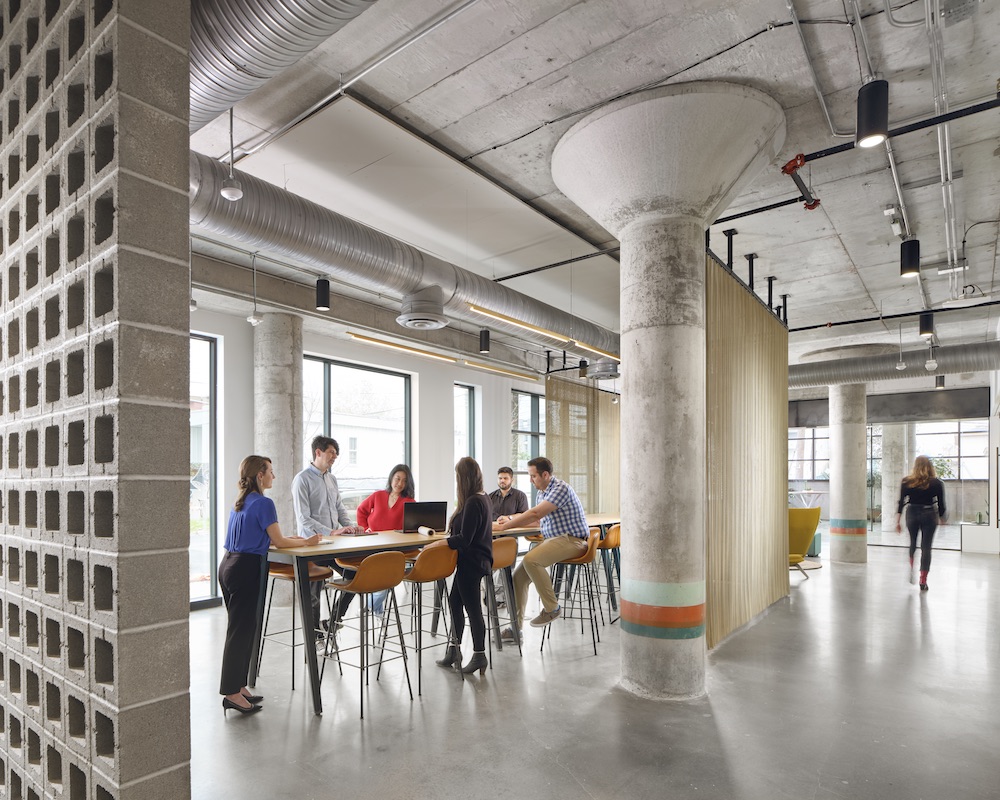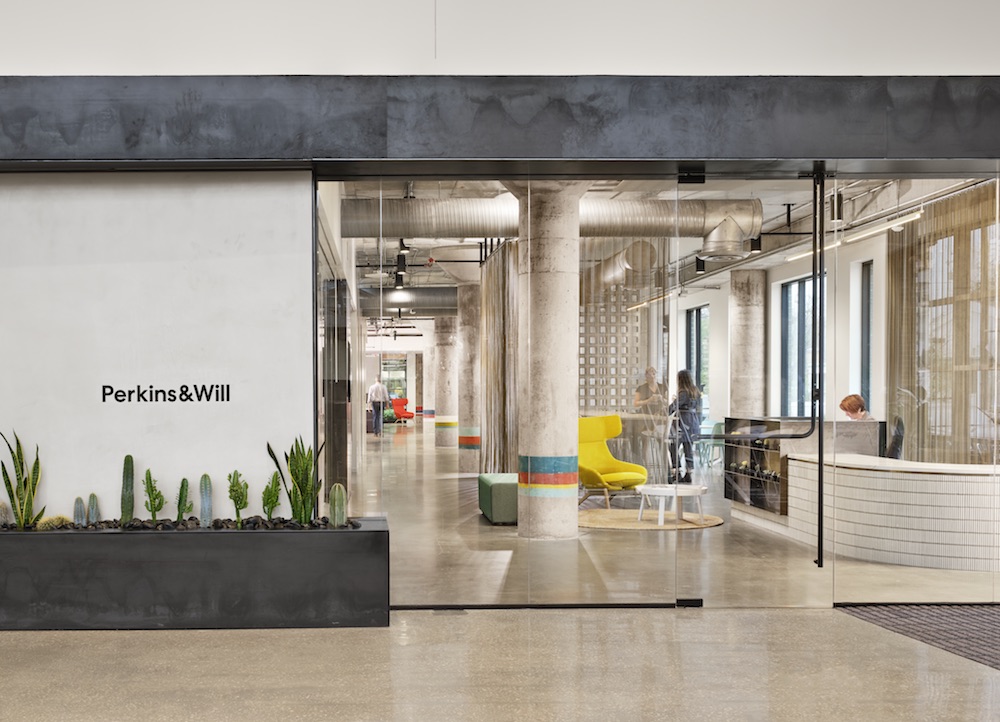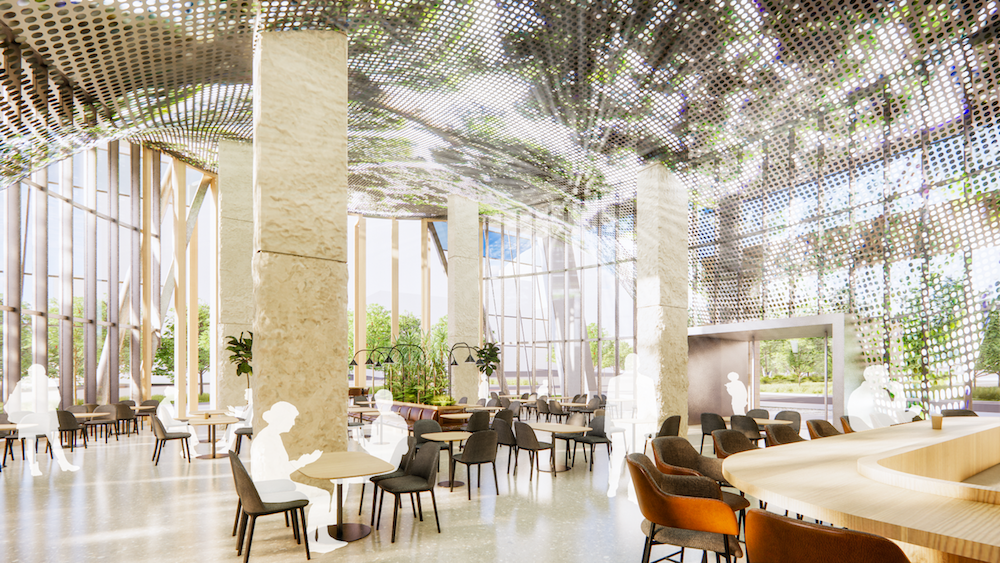The pandemic has forced many of us to rethink health and wellness through the many facets of our lives. Perkins&Will’s Kimberly Richter explores how branded environments within a corporate setting can benefit employees and their mental health.

Before the pandemic, many companies were already taking steps to prioritize their employee’s health and wellbeing. The industry saw this shift take shape by adding amenities such as wellness rooms, fitness centers, and accessible outdoor spaces. An unexpected approach that corporate interior designers implement is creating innovative branded environments to foster wellness at work. Successfully branded environments can express the values and ethos of a brand through a unique and sensory combination of materiality, light, color, shape, programming, art, graphic design, and more.
It is easy to overlook the importance of branding, but incorporating a brand language in innovative and strategic ways is highly effective in impacting employee wellbeing. For example, consistent brand thinking through material choices, thoughtful moments, and one-of-a-kind experiences cultivate a sense of surprise and resonate with one’s values and mission (they do hear me, mean what they say, etc.). This inevitably results in a deeper staff engagement and connection to a company’s brand.

The Process: Creating a Branded Environment
When designing a branded environment, it is crucial to understand employees’ specific needs and wishes, through choosing to conduct interviews, study behaviors, or solicit surveys with staff. Another option is to analyze market trends through competitive analysis studies and conduct research to determine the issues and opportunities. These inquiries enable us as designers to take our findings and transform them into highly personalized design solutions.

To develop a truly personalized strategy, the design team must look at each project with a fresh set of eyes. Clients come to branding experts looking to differentiate their company in the market and create a sense of authenticity that sustains their competitive edge. Successful brand designers take time to listen and learn about all the nuances that make the client who they are and what they aspire to be. The designer’s job is to find the combination of characteristics representing the company’s unique fingerprint and then translate those characteristics into an environment that intuitively expresses who they are and what they stand for. In a recent project, a multi-functional partition element was created in which the brand’s name serves as both large-scale building signage and interactive seating for both tenants and visitors. The sign sits in the lobby on the ground floor and has many expressions throughout the day, depending on who is sitting there, emphasizing their brand and place’s ever-changing and inclusive nature.

The Benefits: Company Morale
How can branded work environments impact mental health? Following a year spent at home, many employees crave the opportunities for connection and collaboration that the office provides. Companies are moving away from static messaging and are shifting towards environments that cultivate a dialogue with their employees. They are looking for solutions that change the behavior of their space and heighten employee engagement.
Personalization is in high demand. Layering light and color through a space can allow employees to choose the right environment for the task at hand. Creating a relationship between daylight and artificial light allows for each space to feel different throughout the day. Providing employees with variety and versatility through the ability to manage light levels and color tones inspires ownership, improves moods, and can increase productivity.

Color palettes are trending in a more expressive direction, perhaps correlated with a “happiness” factor. Firms are moving away from a strict corporate palette and into a new color model with more variety and flexibility. When Perkins&Will’s branded environments team coordinated with the corporate interiors team on the design for their studio in Austin, they sought to highlight the firm’s new brand identity to signify a new era of self-expression. The space is experienced through a sequence of fresh color vignettes punctuated by each column. The color story inspires a dialogue about their unified practices and diverse cultures.

The COVID-19 pandemic has forced many to rethink various facets of their lives, especially in the workplace. As a result, businesses are making a concentrated effort to focus on mental health and physical wellbeing in unanticipated ways. When people feel that their environment is an expression of who they are and is responsive and adaptive to how they change, it increases a sense of belonging and connection. Branded environments promote company pride, resulting in higher employee retention rates, which leads to added, sustainable benefits for the organization. Overall, branded environments are a way for companies to exemplify employee value.

